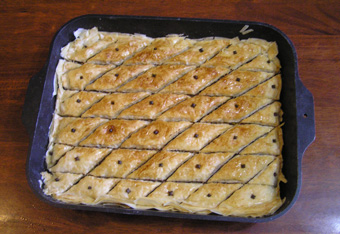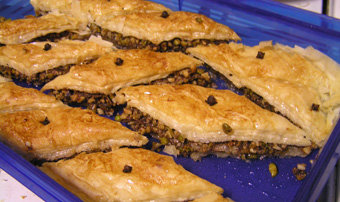 I promise there will be a Timon post in the next day or two, but I’m still rather bushed from the last few weeks, and photo posts always take me hours, so you will just have to make do with a recipe for the time being (not an actual recipe for ‘the time being’, though. I’m not sure what that tastes like, and I haven’t written the recipe for it at any rate). Oh, how you suffer!
I promise there will be a Timon post in the next day or two, but I’m still rather bushed from the last few weeks, and photo posts always take me hours, so you will just have to make do with a recipe for the time being (not an actual recipe for ‘the time being’, though. I’m not sure what that tastes like, and I haven’t written the recipe for it at any rate). Oh, how you suffer!
Don’t be intimidated by this recipe. It’s time-consuming and a little fiddly, certainly, but if you take it slowly it’s actually very easy. And it’s delicious and keeps for days, so it’s worth making the time to make it.
Two tips for filo pastry without tears (of either kind, in fact): first, never buy the frozen version – defrosted frozen filo pastry is unbelievably fragile and will fall apart if you so much as look at it cross-eyed (and after ten or so layers, you will definitely be cross-eyed). Seriously, I’ve given up buying the stuff because it always makes me cry – if it’s a choice between frozen filo pastry and cooking something different for dessert, I will cook the something different every time. Get the stuff from the fridge section. Trust me on this.
Tip two is that olive oil spray is inauthentic but awesome – I don’t, in fact, use it in this particular recipe, but there is nothing to stop you doing so, and I’d certainly use it for this if I were in a hurry or feeling generally impatient. I do use it for a lot of other things. It’s awesome for so many reasons I can hardly count them. For one thing, spraying a layer of olive oil onto filo pastry is much, much faster than brushing it with butter, and lowers your chance of tearing the pastry significantly. For another thing, it’s a bit lower in fat (you use much less of it), and of course it’s also vegan. Olive oil-brushed filo is a bit crispier than the buttery kind, and you might even find you prefer its lighter flavour.
This recipe is lightly adapted from one in Tessa Kiros’s book Food From Many Greek Kitchens. Pretty much my entire feast yesterday came from this book, and it was all lovely, so I can heartily recommend it.
What are you waiting for?
Your shopping list
360 g white sugar 2 tbsp honey strip of lemon peel juice of half a lemon 2-3 cinnamon sticks 150 g almonds 150 g pistachios 2 tbsp caster sugar 2 tbsp cinnamon 22 sheets filo pastry (1 packet should do it) 150 g butter, melted (or your trusty olive oil spray!) 30-50 whole clovesNow what will you do with it?
Start by making the syrup. To do this, put the white sugar, honey, lemon rind, lemon juice and cinnamon sticks in a small saucepan with 250 ml water. Heat very gently, stirring occasionally, until the sugar is completely dissolved (use a metal spoon for this – a wooden one won’t show the sugar crystals), then bring to the boil and simmer for 6 minutes. Let cool.
In a food processor, chop the nuts until they are quite fine, but not almond meal – you want a bit of texture, but no big chunks either. Tip them into a bowl and mix with the sugar and cinnamon. You can use less cinnamon – I just misread the recipe and used 2 tablespoons instead of 2 teaspoons, but I quite liked the effect.
Melt the butter – you can let it go a little brown, if you like. Get a pastry brush and use it to brush melted buttor over the bottom and sides of a good sized, deep baking dish or tin. Mine is about 25 x 35 cm and 4.5 cm deep, and this is about right.
Now for the filo pastry. Get a tea towel nice and damp (but not soaking or you will melt your filo pastry), and lay it flat on the table. Get your filo pastry out of the packet, unroll it and lay the whole thing on the tea towel (most recipes suggest using one sheet at a time and wrapping the rest in the tea towel as you deal with each individual sheet – I find that this just means I spend more time rolling and unrolling the pastry, and since every time I do this, I risk tearing it, I prefer to minimise this). If you are clever, now is the time to cut the whole pile to the size of your tin – otherwise you will need to trim every so often as you layer it.
Brush the top layer of filo pastry with melted butter, and lay it in the tin. Brush the next layer with butter, and lay it over the first. Repeat until you have ten layers. (Now you can cover your unused pastry with another tea towel for a bit to prevent it drying out, if you like.)
Spread half the nuts over the pastry, and cover with two more layers of buttered filo pastry. Spread the rest of the nuts over ths, and then cover with ten more layers of buttered filo pastry, buttering the final layer.
Get a sharp knife and cut the whole thing into parallelograms (or diamonds, if you are feeling less mathematically inclined), and stud the centre of each with a clove, because this looks awesome. When you cut it, cut through all the layers if possible – this will make life easier when you come to serve it.
Flick a little cold water over the top to prevent the edges curling up, and pop into the oven at 180°C for 25 – 30 minutes, until nicely golden.
Pour over half the syrup while it is still hot, wait a few minutes for it to sink in, then pour over the other half. Let cool in tin, and serve at room temperature, preferably from the tin, because it looks gorgeous in all its little parallelograms.
Variations
I think we need to just accept that this is never going to be nut free or gluten-free (let alone low-GI) and move on. Unless someone invents gluten-free filo pastry. But given how fragile the gluteny kind is, I don’t like their chances. Though now I’m wondering what would happen if one tried to make a rice-paper baklava. Maybe we could get this gluten-free after all…
To veganise this or make it dairy-free, olive oil spray is obviously the way to go. There are no eggs or other animal products to avoid, so that’s an easy fix.
Traditionally, one makes this with walnuts rather than pistachios, which explains why I never liked the stuff in the past. I imagine cashews would work too. And now I’m wondering what would happen if one used hazelnuts instead of pistachios, and added a handful of cocoa nibs to the nuts before grinding, and a couple of tablespoons of cocoa to the cinnamon and sugar afterwards. Gianduja baklava, anyone? I’d think orange rather than lemon in the syrup, or maybe even adding some espresso coffee would work. I don’t really like hazelnuts, or coffee, so I probably won’t try this, but it does sound like a lovely idea, so if anyone else wants to try it and let me know how it went, I’d be delighted to hear about it.




8 comments for “Recipe: Baklava”